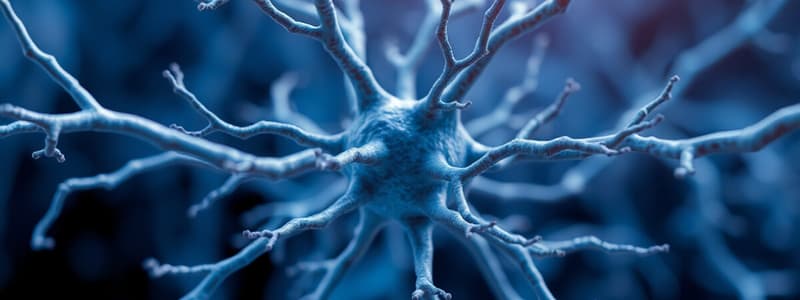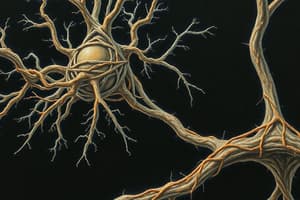Podcast
Questions and Answers
What is the primary role of neurotransmitters in neuron function?
What is the primary role of neurotransmitters in neuron function?
- To generate action potentials.
- To provide structural support to the cell.
- To facilitate communication between neurons. (correct)
- To transport nutrients within the neuron.
Which structure is primarily involved in receiving signals from other neurons?
Which structure is primarily involved in receiving signals from other neurons?
- Dendrites (correct)
- Cell body
- Nerve terminal
- Axon
How do ion channels contribute to the generation of action potentials in neurons?
How do ion channels contribute to the generation of action potentials in neurons?
- They recycle neurotransmitter vesicles.
- They allow neurotransmitters to pass through.
- They permit the flow of ions across the membrane. (correct)
- They alter the lipid bilayer structure.
What best describes the composition of the phospholipid bilayer in cell membranes?
What best describes the composition of the phospholipid bilayer in cell membranes?
Which characteristic of the neuronal cell membrane allows for its fluid behavior?
Which characteristic of the neuronal cell membrane allows for its fluid behavior?
What is the function of cytoskeleton in neurons?
What is the function of cytoskeleton in neurons?
What feature of small uncharged molecules affects their ability to pass through the lipid bilayer?
What feature of small uncharged molecules affects their ability to pass through the lipid bilayer?
What action does exocytosis perform in neuronal function?
What action does exocytosis perform in neuronal function?
What is the initial step in the process of transcription?
What is the initial step in the process of transcription?
What role do proteins play in gene expression?
What role do proteins play in gene expression?
During translation, what is the direct product of the process?
During translation, what is the direct product of the process?
Where are proteins primarily synthesized within a cell?
Where are proteins primarily synthesized within a cell?
Which statement best reflects gene expression variability?
Which statement best reflects gene expression variability?
What is the role of an ACTIVATOR protein in transcription?
What is the role of an ACTIVATOR protein in transcription?
How can transcription be regulated in eukaryotes?
How can transcription be regulated in eukaryotes?
What can lead to changes in transcription and protein expression?
What can lead to changes in transcription and protein expression?
Which neuron type would most likely have different dendritic morphologies?
Which neuron type would most likely have different dendritic morphologies?
What is true about the function of motor proteins in the cytoskeleton?
What is true about the function of motor proteins in the cytoskeleton?
Which type of molecules can generally cross the cell membrane at a slow rate?
Which type of molecules can generally cross the cell membrane at a slow rate?
What is the main function of the proteins found in the cell membrane?
What is the main function of the proteins found in the cell membrane?
How does the chemistry of amino acids influence protein structure?
How does the chemistry of amino acids influence protein structure?
Which of the following best describes an α-helix in protein structure?
Which of the following best describes an α-helix in protein structure?
What is the role of the lipid bilayer in the cell membrane?
What is the role of the lipid bilayer in the cell membrane?
Which of the following correctly describes β-sheets?
Which of the following correctly describes β-sheets?
What facilitates the spontaneous folding of a peptide chain into its final structure?
What facilitates the spontaneous folding of a peptide chain into its final structure?
Why must proteins adapt to interact with the hydrophobic interior of the lipid bilayer?
Why must proteins adapt to interact with the hydrophobic interior of the lipid bilayer?
What is the orientation of microtubules in axons?
What is the orientation of microtubules in axons?
What role do intermediate filaments play in neurons?
What role do intermediate filaments play in neurons?
Which type of cell structure is responsible for intracellular transport?
Which type of cell structure is responsible for intracellular transport?
Which component of the cytoskeleton extends in a circular pattern and strengthens the epithelium?
Which component of the cytoskeleton extends in a circular pattern and strengthens the epithelium?
What is a primary function of mitochondria in neurons?
What is a primary function of mitochondria in neurons?
What structural feature is associated with the axon hillock?
What structural feature is associated with the axon hillock?
What is the significance of the electrochemical gradient in neurons?
What is the significance of the electrochemical gradient in neurons?
What is the primary source of building blocks for neurotransmitters in neurons?
What is the primary source of building blocks for neurotransmitters in neurons?
What is the role of motor proteins in relation to the cytoskeleton?
What is the role of motor proteins in relation to the cytoskeleton?
Which type of filament is primarily involved in muscle cell contraction?
Which type of filament is primarily involved in muscle cell contraction?
Flashcards are hidden until you start studying
Study Notes
Neuron Structure and Function
- Neurons are specialized cells designed for rapid signal transmission.
- Electrical signals within neurons (intracellular) are fast, while chemical signals between neurons (intercellular) occur at synapses.
- Information flows through dendrites to the cell body, along the axon, and terminates at the nerve terminal, forming synapses with target cells.
- Neurons exhibit diverse arrangements of dendrites and axons to perform varied functions.
Components of Neurons
- Neurons contain long axons and intricate dendrites.
- Key structures include ion channels and transporters necessary for action potential generation.
- Receptors on the cell membrane facilitate cell signaling, while exocytosis and endocytosis manage neurotransmitter release and recycling.
Cell Membrane Characteristics
- The cell membrane is a fluid mosaic, with lipids and proteins mobile within the bilayer, contributing to a dynamic environment.
- The lipid bilayer mainly comprises phospholipids, which have polar (hydrophilic) head groups and non-polar (hydrophobic) tails.
- Membranes selectively permit small hydrophobic molecules to pass; large polar molecules and ions have restricted movement.
Protein Functionality and Structure
- Proteins on the cell membrane vary in function and form based on amino acid sequences.
- Amino acids possess side chains categorized into four functional groups, influencing interactions with ions.
- Protein folding minimizes energy through noncovalent bonds, leading to secondary structures like α-helices and β-sheets.
Translation and Protein Synthesis
- Protein synthesis occurs in the cytoplasm or on the rough endoplasmic reticulum (ER), followed by transportation to specific cellular locations.
- Gene expression varies in efficiency; transcription factors and activator proteins can regulate gene output by interacting with promoter and enhancer regions.
Neuronal Diversity
- Different neuron types exhibit unique dendritic morphologies, reflecting their specialized roles.
- Examples include cerebellar Purkinje cells and motoneurons from different species.
Cytoskeleton and Transport
- The cytoskeleton provides structural support with microtubules organized for efficient transport of vesicles throughout the neuron, powered by motor proteins.
- Actin filaments play roles in cellular movement and maintaining cell shape.
Intermediate Filaments
- Neurofilaments form a circular pattern around the nucleus, contributing to mechanical strength and structural integrity within the neuronal epithelium.
Mitochondrial Function
- Mitochondria generate ATP, essential for neuron energy needs and the synthesis of neurotransmitters from amino acids and other compounds.
Neuronal Energetics
- Neurons are high-energy cells, relying on glycolysis and the citric acid cycle for neurotransmitter precursors.
- The axon hillock marks the initiation site of action potentials, with critical structures such as microtubules facilitating neuron function.
Overall Cell Functionality
- Despite their specialization, neurons must perform fundamental cellular functions, relying on membranes for electrochemical gradients crucial for electrical signaling.
Studying That Suits You
Use AI to generate personalized quizzes and flashcards to suit your learning preferences.




